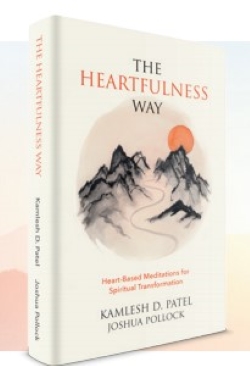
There have been many books written about how to meditate, where to meditate and why to meditate. But none have been a conversation where the essence of spiritual transformation is captured through a dialogue between a guru and his disciple. The Heartfulness Way, a book co-authored by Kamlesh Patel and Joshua Pollock, does just that as it weaves in subtle messages about mindfulness and spirituality through anecdotes, examples and stories.
This light-hearted and simple read contains illuminating answers by Kamlesh—the fourth guru in the Heartfulness lineage who is widely known as “Daaji” in India—to profound questions by Joshua, his student. From reflecting on the essence of prayer and yogic transmission to demystifying the act of meditation, the book looks at reality beyond rituals. It preaches the importance of centering oneself at the core—the heart—and finding peace and contentment there.
Through anecdotes, Kamlesh tells his student about desires, emotions, attachments and feelings, and how best to understand the effect of meditation on everything. In one instance, he provides an analogy of a restless child who desires an ice-cream and quietens down once she receives it. But he warns that “she will most likely ask for ice cream the next time she feels unsettled.”
“With a temporary object of meditation, your fulfillment is temporary. Afterward, you become restless again,” he tells the narrator as he delves into the cycle of desire and fulfillment, comparing our wants and needs to pendulums that swing between lack and fleeting happiness.
Kamlesh says the first problem is that we have trained ourselves to be restless without a particular thing or moment that we desire, and we learn to be unhappy without it. The second problem is that by repeatedly fulfilling a particular desire, we develop tolerance to that fulfillment. The mind is not happy with limitation or temporary states of happiness, it seeks infinity, Kamlesh says. “The mind seeks not merely meditation, but endlessness in meditation. That is true meditation, profound meditation.”
Another profound example about our subconscious thought is portrayed through a story of a little boy who wants to be a “flying yogi”, and under the guidance of his teacher, does everything to attain that goal. When the final night of training arrives, the teacher tells the boy to meditate at night, but “whatever may happen, don’t think of monkeys.” Your guess is as good as mine—the only thought the poor boy has all night is of monkeys.
“Trying not to do something is counterproductive,” advises Kamlesh. “To enforce a state of effortlessness upon yourself requires the biggest possible effort you can make.”
We only drop our efforts when we become content. We are content only when we drop our efforts. “It’s a catch-22.”
While on one hand, the book weaves in concepts of consciousness and spirituality, it also touches upon Patanjali’s Yoga Sutras, as well as lists down steps to help your body relax before focusing on the heart, which is the meditation technique sought by all who practice “the heartfulness way.” He also explains the “cleaning method”, a core practice of Heartfulness—its purpose is to free us from patterns of thinking, emotional reactivity, and behavioral tendencies.
Pick up this book if you want to learn to meditate with your heart, or if you want to know how emotions are different from feelings, or understand the role of ego within our spiritual anatomy. From page to page, this book will enlighten and leave you feeling centered and at peace—as though you just did a Heartfulness meditation with your eyes open.
Review written by Kavita Chandran, Editor With over a million practitioners worldwide, Heartfulness meditation (www.heartfulness.org) was started in India in 1945, and is a set of practices for self-development. The meditation is offered free of cost and is appropriate for all walks of life, religions, cultures and ages over 15.
To know more about Heartfulness Meditation in Singapore, visit www.heartfulness.sg/
This article was first published in the print edition of Yoga Journal Singapore, which is now Yogahood Online.







